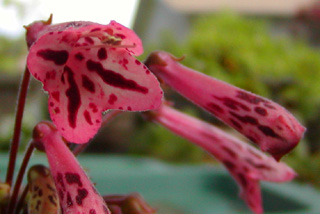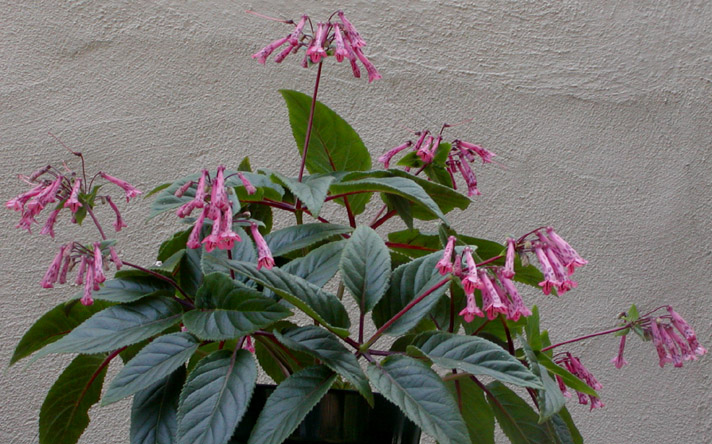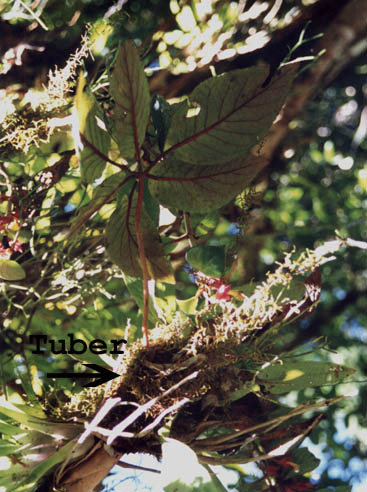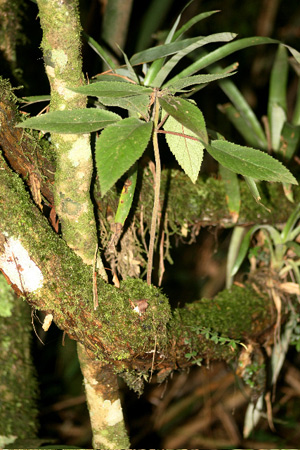Sinningia douglasii
- Blooming
- In Habitat
- My history with this species
- Hybridization
- Feature table
- Publication and etymology
An epiphytic and "roof-o-phytic" sinningia.

| Species list |
Hybrids list |
Tubers list |
Topics list |
Site index |
What's new |
Home page |
Sinningia douglasii
An epiphytic and "roof-o-phytic" sinningia. |

|
Here is a picture of most of my best plant, in May 2007. It had nine blooming stalks.

|
Blooming season, in spring, is short but intense. A mature tuber can produce a hundred or more flowers. They open over a relatively short period, so before you know it, the blooming period is done. Our local hummingbird, Calypte anna, often visits S. douglasii when it blooms here in May. |
|

|
In HabitatS. douglasii is epiphytic. This terrible picture, from the 1999 expedition of the Gesneriad Research Foundation (GRF), attempts to capture S. douglasii growing on a tree branch. Below it, projecting to the left, is a bromeliad, and the red smudge to the right of the S. douglasii stem is an out-of-focus flower of Nematanthus tessmannii. The poor quality of this photograph is a result both of my inexperience and the difficulty of taking a picture up into a brightly lit sky. Even so, the characteristic whorl-of-six leaf pattern and the distinctive red midribs and leaf veins can clearly be seen. This was in April, Brazil autumn, so that the flowering season of Sinningia douglasii was long past, and the leaves were starting to turn yellow in preparation for dropping. We also saw S. douglasii growing in the furrows of tiled roofs, where enough plant debris had accumulated to support opportunistic vegetation. |
|
This picture, taken in Brazil by Jim Roberts, shows a Sinningia douglasii tuber in the angle formed by a broken (and probably dead) branch. The life expectancy of this plant is not great; when that branch decays enough to give way, the tuber will presumably fall to the ground. Like other tubers observed in habitat, this one is covered by its own epiphytes, here predominantly mosses. This picture was taken in January 2009, and thus about three months earlier in the season than the picture above, taken in April 1999. |

|
My history with this speciesIn the early eighties, I sowed seed of "Sinningia verticillata" and got one good plant. It took about six or seven years, but it eventually rewarded my patience with flowers, in 1989. Around Christmas 1990, while I was visiting family in Seattle, and therefore unable to protect my plants, we had a spell of unanticipated cold weather, with daytime temperatures around freezing, which is very unusual for the San Francisco Bay Area (it has not happened since then). I returned to find many plants dead or severely damaged. The top of the "S. verticillata" tuber rotted. The bottom remained alive and firm for about three years, but never sprouted. In 1993, I got more seed from the AGGS Seed Fund. My best plant of this species originated from that sowing, and has provided a lot of seed back to the Fund over the years. HybridizationI believe that S. douglasii has been crossed with many of the other members of the Dircaea clade. Given the results of other intra-Dircaea hybrids, all such crosses are likely to be fertile. I crossed Sinningia douglasii with S. leucotricha, and got flowers in May 2007 (the cross has its own page). A couple of seedlings of the cross between S. douglasii and S. 'Distant Lights' (S. leopoldii x sp. "Black Hill") have bloomed, but aren't very impressive. In general, crosses with S. douglasii have been disappointing. Both the leucotricha cross and that with 'Distant Lights' have (so far) borne relatively few flowers, even though S. douglasii itself is a heavy bloomer. [Update, July 2009]: one plant of S. douglasii x leucotricha has done better with age; see the picture. S. douglasii hybrids must be very rare in cultivation, since I have not heard of any others (by contrast with, for instance, S. eumorpha, >S. conspicua, S. cardinalis, S. reitzii, and S. leucotricha, which have been used in a lot of crosses). Although the related S. piresiana is not as impressive a plant as S. douglasii, its hybrids are usually good plants with abundant bloom. |
| Plant Description |
|
| Growth | Determinate |
| Habit | Stems upright (if one) or spreading (more than one) |
| Leaves | Dark green with red midrib and veins prominent on reverse. Leaves are sessile. Mature plants have two close whorls of three leaves each. |
| Dormancy | Stems fully deciduous. Dormancy is obligate. |
Flowering |
|
| Inflorescence | terminal peduncle |
| Season | Blooms in spring -- many flowers, but short blooming season |
| Flower | Dark red or pinkish, tubular, with dark purple streaks on inside of corolla, often on outside as well. Bottom three corolla lobes have single dark longitudinal stripe (see picture at top of page), a feature often passed to hybrid offspring. |
Horticultural aspects |
|
| Diagnostic features | Whorled, sessile leaves (see above under Leaves), corolla spotted with three stripes on lobes (see above under Flower). |
| From seed | 28 months to bloom, under my conditions |
| Hardiness | Has survived 30F (-1C) in my yard, did not survive 20F (-7C). |
| Recommended? | Absolutely! Great flowers, great foliage, great tuber. Of all the mid-size sinningias, this species has the tidiest and most elegant foliage, distributed symmetrically about the tuber. Just one burst of flowers in the spring, however, so have something else for the rest of the year. |
Hybridization |
|
| Hybrids with this species | See listing. |
Botany |
|
| Fruit | Conical, about 1.2 cm [0.5 inch] long, with a short beak. Calyx dark red-brown, lobes to 2 mm clasp only base of fruit. At this point, nectaries visible. Fruit is green with upper surface and tip flushed with red until ripe. |
| Nectaries | Two, separate, dorsal |
| Taxonomic group | The douglasii group of the Dircaea clade. |
|
Sinningia douglasii used to be known as S. verticillata, in acknowledgment of the "verticillate" (see etymology) growth habit, meaning having leaves in whorls. A mature plant of this species normally has its leaves in two whorls of three, but the whorls are so close together that they appear to be a single whorl of six.
Unfortunately, a prior publication under the name Gesneria douglasii
was discovered, which, by the sometimes tyrannical laws of
botanical nomenclature, meant that a pleasant name had to be
scrapped in favor of a grating one.
As can be seen at the bottom of this page, neither the
original publication nor the first verticillata reference
were under the name sinningia.
Makes no By happy coincidence, however, new collections were made of this species just about the time of the name change. S. verticillata was notorious for taking six-seven years to bloom from seed, but the plants collected in the late 80s and early 90s were much faster to flower. The Smithsonian website gives a long list of published synonyms for S. douglasii. If I understand the listing correctly, the crucial ones were
If only species name counts in the taxonomic tug-of-war, then douglasii beat out verticillata by two years, almost two centuries ago! Of course, if somebody could find an 1825 publication of this plant under the name Tyrannocarpus verticillatus, we could all go back to calling it verticillata. |